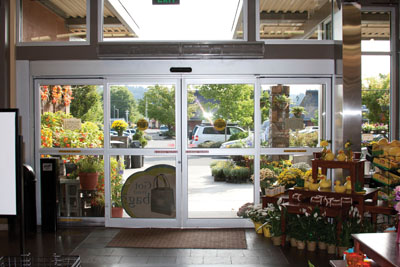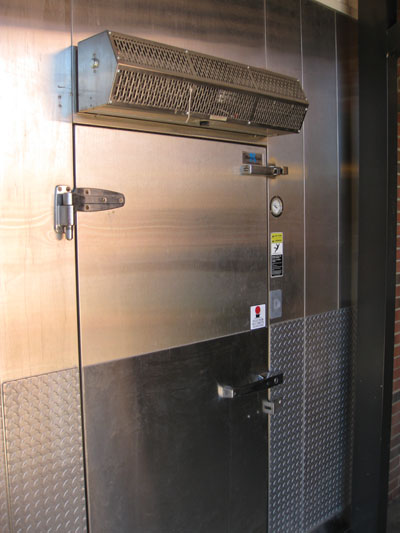Air curtains help retailers perform green.
With the onslaught of energy saving devices on the market today, many retailers admit perplexity about which technologies actually work or produce a payback that’s profitable.
The key word is “payback.” Environmental consciousness might project a great corporate image, but if the payback on the latest green technology is 7 to 15 years, that’s a strain on bottom line profitability.
Amidst all the media hype on solar and wind power, the air curtain is one of the best energy savings devices for the amount of investment capital it requires and the payback it delivers. While air curtains might not have the gleam of the latest green high technology, air curtains are still one of the most effective weapons against energy losses. Smart retailers are putting their annual construction budgets to good use by installing air curtains on back doors, entrances, drive-thru windows and also walk-in coolers.
Retailers looking for a role model of energy conservation through the use of air curtains need to look no further than the small eight-store supermarket chain, Market of Choice, in Eugene, Oregon. Many retailers use air curtains on back-end shipping doors, especially in California where the California Health and Safety Code mandates air curtains on back-end and shipping doors of all foodservice establishments; however, the 32-year-old, family-owned Market of Choice puts air curtains on front entrances as well as back doors.
Retailers install air curtains on back doors typically to eliminate flying insect infiltration; however, front door applications are critical to energy savings and employee comfort as well as flying insect protection.
 Before one btu was saved on any of the seven stores using front entrance air curtains, Market of Choice saved tens of thousands of dollars per location just in construction costs by substituting vestibules with automatic sliding doors with air curtains. Vestibules cost up to 75% more in labor/materials than air curtains, and they also consume anywhere from 50 to 2,000 square feet of valuable retail floor space. While they carry expensive construction costs, vestibules do conserve energy because as one door opens, another closes and prevents a breezeway where heated and cooled air escape or outdoor environmental elements can infiltrate. That’s a good strategy; unfortunately, multiple people in the vestibule create a scenario in which both doors are open simultaneously and create a wind tunnel into the store.
Before one btu was saved on any of the seven stores using front entrance air curtains, Market of Choice saved tens of thousands of dollars per location just in construction costs by substituting vestibules with automatic sliding doors with air curtains. Vestibules cost up to 75% more in labor/materials than air curtains, and they also consume anywhere from 50 to 2,000 square feet of valuable retail floor space. While they carry expensive construction costs, vestibules do conserve energy because as one door opens, another closes and prevents a breezeway where heated and cooled air escape or outdoor environmental elements can infiltrate. That’s a good strategy; unfortunately, multiple people in the vestibule create a scenario in which both doors are open simultaneously and create a wind tunnel into the store.
For that and other reasons, air curtains are more effective at conserving energy than vestibules, according to the energy study “Air Curtains: A Proven Alternative to Vestibule Design” verified by second-party research/validation consultant, Blue Ridge Numerics of Charlottesville, Virginia. The study used computational fluid dynamics (CFD) analysis technology to prove that an air curtain/automatic door combination is 60% more effective in environmental separation performance than conventional automatic two-door vestibules.
Market of Choice didn’t immediately install air curtains in the single door entrances, however. The move to eliminate vestibules was good for bottom line construction costs; however, employee comfort at the Wilakenzie Street store was the impetus for the chain’s first front-end air curtain installation.
A long-time electrical contracting vendor and consultant for Market of Choice, Jared Olsen, president of Eugene, Oregon-based Revolution Electric, first suggested air curtains to stop Wilakenzie’s cold northwest wind infiltration that chilled point-of-purchase employees and customers during door cycling.
Subsequently, Market of Choice has used aesthetic stainless steel air curtains to blend in unobtrusively with seven of its eight stores’ automatic door entrances. The air curtain technology draws interior air from the facility and discharges it through field-adjustable (+/-20 degree) linear nozzles that “seal” the doorway with a non-turbulent air stream that meets the floor approximately at the threshold of the door opening. A properly-sized and AMCA-certified (Air Movement & Control Association in Arlington Heights, Illinois) air curtain can contain approximately 70% to 80% of that air and return it to the space. Because the air curtain discharges air at velocities generally in the range from 1,000 to 3,000 feet per minute, it effectively prevents outside air and flying insect infiltration. The air curtains are activated by a limit switch that’s triggered when the door opens and deactivated on a 5-second delay setting on a programmable controller.
Like all mechanical equipment, however, air curtains need routine check-ups to assure their efficacy. Therefore, Olsen trains Market of Choice store managers to periodically inspect the air curtains for airflow, cleanliness, proper louver angle, fan speed and other critical performance parameters.
Air curtains are just a part of Market of Choice’s green mission. The chain also sells power generated from its own 130.0 kW solar photovoltaic (PV) electric rooftop system, and even composts its own food waste. Market of Choice is also in the middle of an ambitious energy-saving light bulb change-out program from overhead high-intensity discharge (HID) and reach-in cooler/freezer fluorescent light bulbs to LED lighting.
Air Curtains for Walk-In Cooler Energy Savings
Now retailers are looking beyond back-door and front-end air curtain applications and looking internally at walk-in coolers to squeeze more energy savings out their operations. A recent change  in the Energy Policy and Conservation Act (Section 312) affects just about any operation that sells food or prepares it. The code mandates that walk-in coolers (manufactured after January 1, 2009) include strip curtains, spring-hinged swinging vinyl doors or other air infiltration reduction methods.
in the Energy Policy and Conservation Act (Section 312) affects just about any operation that sells food or prepares it. The code mandates that walk-in coolers (manufactured after January 1, 2009) include strip curtains, spring-hinged swinging vinyl doors or other air infiltration reduction methods.
An air curtain, which falls into the latter category, separates a walk-in cooler’s exterior and interior environments similarly to pedestrian and shipping doorways. Air curtains require less maintenance, are more effective, have a longer lifespan, and offer a safer unobstructed view into the walk-in cooler. Depending on the number of door cycles, the retailer can expect a 2-year or less payback of energy savings, traffic volume, increased equipment efficiencies, and reduced refrigeration equipment wear and tear.
Some walk-in cooler manufacturers are now offering air curtains as options on new installations.
Retrofits can be challenging and costly. However, some manufacturers are offering a kit that includes an air curtain designed for walk-in coolers, pre-wired control/load center with enclosure, and a magnetic reed on/off door switch. The kit reduces installation time from hours to just 15 minutes for a contractor or in-house maintenance staffer.
Third-Party Tests Prove Air Curtain Advantages
Wexford, Pennsylvania-based Donoghue & Pivirotto Enterprises Inc., a QSR franchisee that operates four Arby’s stores, saw great potential in reducing walk-in cooler energy use, so it did its own testing. The franchisee performed a 2-week audited test on a 10 x 12-foot walk-in cooler at its 3,300-square-foot Arby’s in Butler, Pennsylvania. After outfitting the walk-in cooler entrance with an air curtain, the results proved that the refrigeration circuit’s compressor ran 1.75 hours less during 1 week — a 27% reduction in compressor run time and equipment wear and tear. The improvement results in nearly 100 fewer operating hours per year for an estimated annual savings of $447 and a 1.6-year payback on a walk-in cooler entrance air curtain.
Additionally, the air curtains undoubtedly require less maintenance, have longer life spans and are safer for employee passage than the alternatives, according to Doug Cygan, vice president of operations for Donoghue & Pivirotto Enterprises. Other Energy Policy and Conservation Act (EPCA) (Section 312) options Cygan considered were strip curtains and hinged vinyl doors — neither of which seal a doorway as well as air curtains. Cygan also said they both impede employee ingress and, in the long run, employees are likely to break company rules and tie the strip curtains out of the way to a piece of conduit because they’re not very user-friendly.
The Arby’s test results are also substantiated by other retailers who are testing air curtain effectiveness on everything from entrance doors, drive-thru windows and now walk-in cooler doors. While high technology such as solar and wind power tend to get the most media attention, technology such as air curtains has decades of proven results in energy savings and short payback. Retailers are now taking notice of the potential bottom line operational savings.
— Joe Banas is the national sales manager for the foodservice division of New Castle, Pennsylvania-based Berner International, an air curtain manufacturer. He is a 36-year-veteran of the foodservice industry. Banas can be reached at [email protected].
